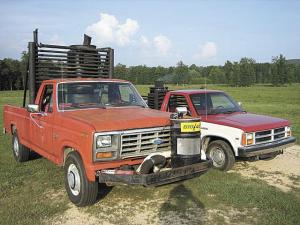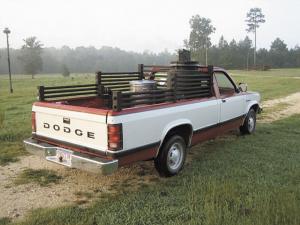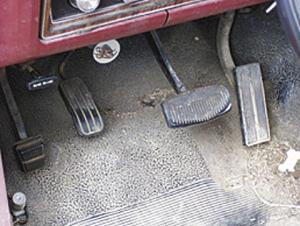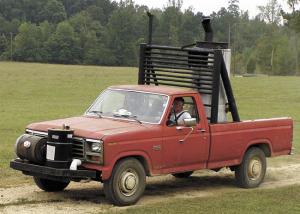2006 - Volume #30, Issue #6, Page #20
[ Sample Stories From This Issue | List of All Stories In This Issue | Print this story
| Read this issue]
Wood-Burning Truck Gets 9,000 Miles Per Cord (MPC!)
 |
 |
 |
 |
"I modified the differential on it to give it a high speed rear end, and then installed an overdrive," says Keith. "Wood gas will only run a car motor to about 2,400 rpm's, but with the changes I can get the truck up to 91 mph. I can go 80 to 90 miles on a single fill of wood."
His first effort (still used as a farm truck) has an 80-gal., 6-ft. tall gasifier barrel. It looks like a big water heater standing up in the rear box with wood gas radiator panels standing several feet above the cab. A 30-gal. barrel on a platform over the front bumper is filled with hay and serves as a filter for the cooled gases.
The 1987 Dakota is Keith's second wood-fired truck. Although it looks like a standard truck, it has a smaller gasifier standing in the truck box and a filter built into the bed. Wood gas radiator pipes look like sideboards.
With both units, Keith fuels up by filling the barrel with small chunks of wood. He reports that it takes only about 45 seconds for enough wood gas to be produced to run the trucks.
"The new gasifier holds about 30 gal. and only sticks above the cab by about four to five inches, adding hardly any wind resistance," says Keith.
Dr. David Bransby, professor, Energy Crops and Bioenergy, Auburn University, is a nationally recognized expert on biomass conversion. He has worked closely with Keith, evaluating his gasifier and experimenting with non-wood fuels from chicken litter to corn and switchgrass cubes.
"We've put all kinds of stuff in there, and as long as it meets certain requirements, it works fine," says Bransby.
The down draft gasifier limits the amount of oxygen available to the burning fuel. This creates incomplete combustion of "syngas" which would normally be burned or released into the environment as smoke. It comes out of the firebox as hot as 2,000¦ F. Thus the need for the radiator side boards to cool the gas. Once cooled down, it's piped through the hay filter and then to the carburetor where it replaces gasoline.
One of the beauties of the system is that relatively few changes need to be made to the existing truck and fuel system. The cab does have a few added dials and controls.
"I have some temperature and pressure gauges to tell me what's going on in the syngas generator," says Keith.
He starts his truck on gasoline and then switches over to wood gas. A second gas pedal installed on the floorboard controls wood gas flow. To switch between gasoline and wood gas, Keith simply moves his foot from one pedal to the other, while mixing the two is as almost as simple as pressing down on both pedals at once.
"I also have a valve that manages the air-to-fuel ratio in the carburetor, so I can adjust it as I drive and as the syngas production density changes," says Keith.
When pulling a load up a hill where he needs more power, all he does is press down on the gasoline pedal. "The trucks work great on wood gas for driving around local roads, but when I get on the interstate, I will add about 5 percent gasoline to get up to faster speeds more quickly," he says.
The only regular maintenance required is to clean out the grates on the gasifier. Keith cleans it about every 1,000 miles.
"I built the second gasifier with an opening under the grates," he says. "All I have to do is open it up and stick a suction hose in the top to clean out the ashes."
Keith's next project is to adapt the gasifier to power an electrical generator. He's working with a 7 kW unit that will sit in the back of the pickup. Keith plans to drop an intake column into the gasifier to pull gas directly to the generator.
Contact: FARM SHOW Followup, Wayne Keith, 1950 Saint Clair Rd., Springville, Ala. 35146 (ph 205 410-6829, waynekeith01 @alltel.net).

Click here to download page story appeared in.

Click here to read entire issue
To read the rest of this story, download this issue below or click here to register with your account number.




